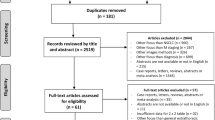Abstract
Background
Whole-body magnetic resonance imaging (MRI) has been investigated by multiple authors as a radiation-free alternative to positron emission tomography computed tomography (PET-CT) in children with lymphoma.
Objective
To evaluate the sensitivity, specificity, and diagnostic odds ratio of whole-body MRI compared to PET-CT for the staging of pediatric lymphoma.
Methods
The databases PubMed, Embase, and Scopus were searched for studies that reported the accuracy of whole-body MRI compared to PET-CT for lymphoma staging in children. Data was collected from included studies to formulate 2 × 2 contingency tables, including the number of true positive, true negative, false positive, and false negative. The pooled sensitivity, specificity, and diagnostic odds ratio (DOR) were calculated. Summary receiver operating characteristic curves were drawn and the area under the curve (AUC) calculated. In addition, the Quality Assessment of Diagnostic Accuracy Studies 2 (QUADAS 2) tool was used to assess the risk of bias and applicability concerns.
Results
A total of seven studies were included in the final analysis. Of these, six studies used unenhanced whole-body MRI. The pooled sensitivity of whole-body MRI-based staging was 95.8%, while the pooled specificity was 21.8%. The DOR for whole-body MRI was 1.19. For extranodal staging, the pooled sensitivity was 88.9%, specificity was 97.4%, and DOR was 25.29. The partial AUC for overall staging was 0.63, whereas that for extranodal staging stood at 0.88. Based on the QUADAS 2 tool, all seven studies were at risk of bias (six at high risk, one at unclear risk).
Conclusion
Whole-body MRI has high sensitivity for staging of pediatric lymphoma and may be a useful alternative to PET-CT.
Graphical abstract





Similar content being viewed by others
Data availability
The datasets generated during and/or analyzed during the current study are available from the corresponding author on reasonable request.
References
Li W (2021) Pathogenesis and pathology of pediatric lymphoma. In: Gallamini A, Juweid M (eds) Lymphoma. Exon Publications
McCarten KM, Nadel HR, Shulkin BL, Cho SY (2019) Imaging for diagnosis, staging and response assessment of Hodgkin lymphoma and non-Hodgkin lymphoma. Pediatr Radiol 49:1545–1564
Cairo MS, Pinkerton R (2016) Childhood, adolescent and young adult non-Hodgkin lymphoma: state of the science. Br J Haematol 173:507–530
Mauz-Körholz C, Metzger ML, Kelly KM et al (2015) Pediatric Hodgkin lymphoma. J Clin Oncol Off J Am Soc Clin Oncol 33:2975–2985
McInnes MDF, Moher D, Thombs BD et al (2018) Preferred reporting items for a systematic review and meta-analysis of diagnostic test accuracy studies: the PRISMA-DTA statement. JAMA 319:388–396
Whiting PF, Rutjes AWS, Westwood ME et al (2011) QUADAS-2: a revised tool for the quality assessment of diagnostic accuracy studies. Ann Intern Med 155:529–536
Shim SR, Kim SJ, Lee J (2019). Diagnostic test accuracy: application and practice using R software. Epidemiol Health 41:e2019007
Reitsma JB, Glas AS, Rutjes AWS, Scholten RJPM, Bossuyt PM, Zwinderman AH (2005) Bivariate analysis of sensitivity and specificity produces informative summary measures in diagnostic reviews. J Clin Epidemiol 58:982–990
Higgins JPT, Thompson SG, Deeks JJ, Altman DG (2003) Measuring inconsistency in meta-analyses. BMJ 327:557–560
Deeks JJ, Bossuyt PM, Leeflang MM, Takwoingi Y (2023) Cochrane handbook for systematic reviews of diagnostic test accuracy, version 2.0. Cochrane, London
Baranska D, Matera K, Podgorski M et al (2019) Feasibility of diffusion-weighted imaging with DWIBS in staging Hodgkin lymphoma in pediatric patients: comparison with PET/CT. Magma N Y N 32:381–390
Littooij AS, Kwee TC, Barber I et al (2014) Whole-body MRI for initial staging of paediatric lymphoma: prospective comparison to an FDG-PET/CT-based reference standard. Eur Radiol 24:1153–1165
Latifoltojar A, Punwani S, Lopes A et al (2019) Whole-body MRI for staging and interim response monitoring in paediatric and adolescent Hodgkin’s lymphoma: a comparison with multi-modality reference standard including 18F-FDG-PET-CT. Eur Radiol 29:202–212
Punwani S, Taylor SA, Bainbridge A et al (2010) Pediatric and adolescent lymphoma: comparison of whole-body STIR half-Fourier RARE MR imaging with an enhanced PET/CT reference for initial staging. Radiology 255:182–190
Shapira-Zaltsberg G, Wilson N, Trejo Perez E et al (2020) Whole-body diffusion-weighted MRI compared to 18 FFDG PET/CT in initial staging and therapy response assessment of Hodgkin lymphoma in pediatric patients. Can Assoc Radiol J J Assoc Can Radiol 71:217–225
Spijkers S, Littooij AS, Kwee TC et al (2021) Whole-body MRI versus an FDG-PET/CT-based reference standard for staging of paediatric Hodgkin lymphoma: a prospective multicentre study. Eur Radiol 31:1494–1504
Spijkers S, Nievelstein RAJ, de Keizer B, Bruin MCA, Littooij AS (2019). Fused high b-value diffusion weighted and T2-weighted MR images in staging of pediatric Hodgkin’s lymphoma: a pilot study. Eur J Radiol 121:108737
Author information
Authors and Affiliations
Contributions
M.J. conceived, supervised, and supported the study. D.B. collated and analyzed the data, performed the statistical analysis, and drafted the initial manuscript. D.K. supervised the analysis and performed critical revision. All authors reviewed and approved the final manuscript.
Corresponding author
Ethics declarations
Conflicts of interest
None
Additional information
Publisher's Note
Springer Nature remains neutral with regard to jurisdictional claims in published maps and institutional affiliations.
Supplementary Information
Below is the link to the electronic supplementary material.
Rights and permissions
Springer Nature or its licensor (e.g. a society or other partner) holds exclusive rights to this article under a publishing agreement with the author(s) or other rightsholder(s); author self-archiving of the accepted manuscript version of this article is solely governed by the terms of such publishing agreement and applicable law.
About this article
Cite this article
Bhalla, D., Jana, M. & Kandasamy, D. Diagnostic accuracy of whole-body magnetic resonance imaging versus positron emission tomography-computed tomography for the staging of pediatric lymphoma: a systematic review and meta-analysis. Pediatr Radiol 53, 2683–2691 (2023). https://doi.org/10.1007/s00247-023-05775-7
Received:
Revised:
Accepted:
Published:
Issue Date:
DOI: https://doi.org/10.1007/s00247-023-05775-7




